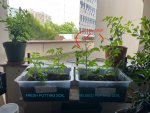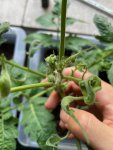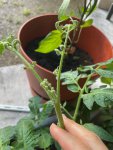Hi all,
I am trying to grow 4 Wild Fred (https://www.dwarftomatoproject.net/product/dwarf-wild-fred/) tomato plants on my balcony in Paris, France.
I have 2 containers with 2 plants in each: the left one is filled with fresh potting soil purchased this year, while the right one is mostly filled with older potting soil reused from last year.

My issue is that the young leaves at the top of both plants in the "Reuse" container are twisted, grow very slowly or not at all, and are not unfurling. I started noticing it 2-3 weeks ago.


I had the same problem last year (with a different variety), and this year I'm not seeing it in the Fresh soil container (although growth is disappointing), so I strongly suspect that it has something to do with my old soil:
- either a soil-borne pathogen, but I haven't been able to find one that really fits the description
- or a nutrient deficiency, but same problem (at first I was using a NK fertilizer, I switched recently to NPK, but phosphorus deficiency looks like it should give a bluish-purple tinge to the leaves, and I haven't observed that)
The problem only affects the young leaves. The older leaves look normal to me, I'm not seeing any curl or wilting even at the hottest time of the day.
Last bit of info: on the first pic you'll see that I also have 2 Cayenne peppers. The left one is planted into old potting soil, and the right one into new. Both have grown quite well in my opinion, but the left one has trouble producing fruits (many blossoms fall without bearing fruit).
Does anybody have a clue what might be going on ? With healthy tomatoes, how long should it take for the young leaves to unfurl ?
With healthy tomatoes, how long should it take for the young leaves to unfurl ?
I am trying to grow 4 Wild Fred (https://www.dwarftomatoproject.net/product/dwarf-wild-fred/) tomato plants on my balcony in Paris, France.
I have 2 containers with 2 plants in each: the left one is filled with fresh potting soil purchased this year, while the right one is mostly filled with older potting soil reused from last year.

My issue is that the young leaves at the top of both plants in the "Reuse" container are twisted, grow very slowly or not at all, and are not unfurling. I started noticing it 2-3 weeks ago.


I had the same problem last year (with a different variety), and this year I'm not seeing it in the Fresh soil container (although growth is disappointing), so I strongly suspect that it has something to do with my old soil:
- either a soil-borne pathogen, but I haven't been able to find one that really fits the description
- or a nutrient deficiency, but same problem (at first I was using a NK fertilizer, I switched recently to NPK, but phosphorus deficiency looks like it should give a bluish-purple tinge to the leaves, and I haven't observed that)
The problem only affects the young leaves. The older leaves look normal to me, I'm not seeing any curl or wilting even at the hottest time of the day.
Last bit of info: on the first pic you'll see that I also have 2 Cayenne peppers. The left one is planted into old potting soil, and the right one into new. Both have grown quite well in my opinion, but the left one has trouble producing fruits (many blossoms fall without bearing fruit).
Does anybody have a clue what might be going on ?


